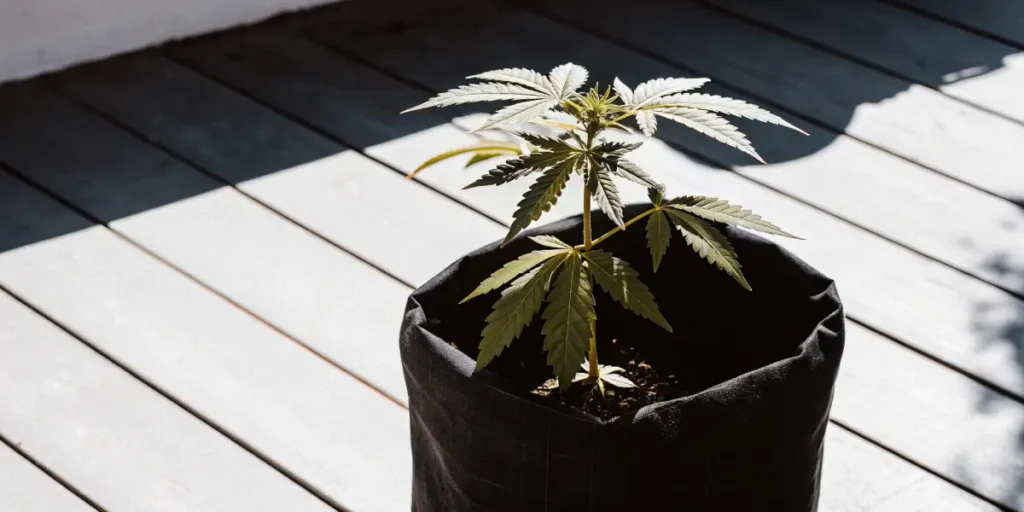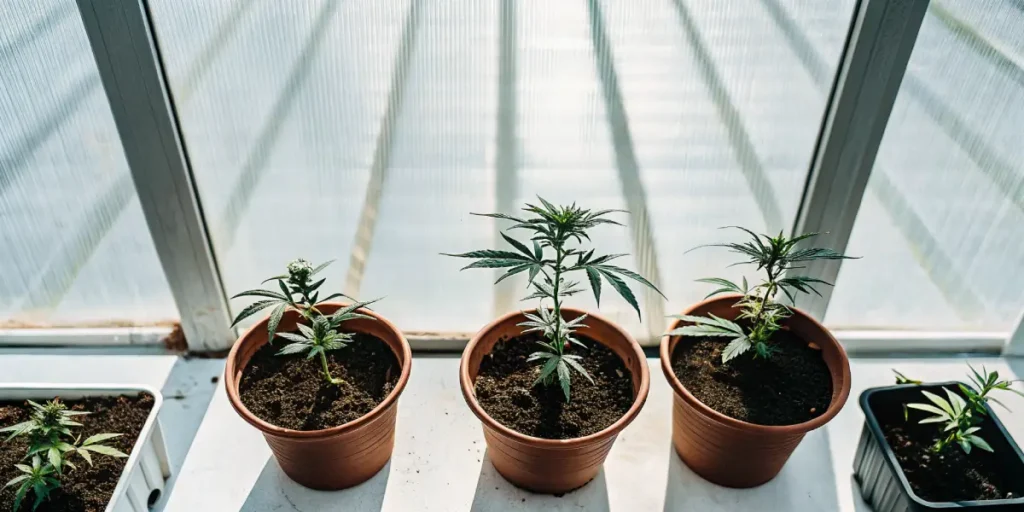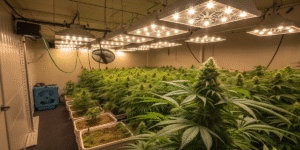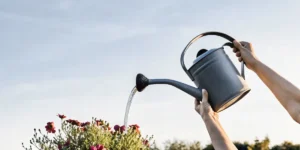Growing autoflower cannabis requires choosing the best pot size for autoflower plants. Getting the size right can make all the difference in your yield and plant health. Autoflowers have a unique life cycle that demands specific attention to their growing environment.
When selecting the best pot size for indoor autoflower plants, it’s crucial to consider the space you have available. Indoor growers often use pots that allow for easy movement and optimal light exposure. This approach helps ensure your plants receive the care they need to thrive, even in confined spaces.
For outdoor gardeners, the recommended pot size for outdoor autoflower plants needs to support robust root growth while withstanding environmental changes. Outdoor growing offers more flexibility in size but still requires thoughtful planning to maximize plant potential.
Factors Influencing Pot Size Choice
The choice of pot size significantly impacts the overall growth of your autoflower plants. Autoflowers have a shorter lifecycle, which means less time to correct mistakes. Hence, choosing the right pot size for autoflower cannabis from the start is crucial.
Root development is a primary consideration. The pot should be large enough to support healthy root expansion, yet not so large that it causes water retention issues. Proper drainage is another factor to consider, as it prevents root rot and other growth problems.
Another factor to consider when determining the ideal container size for autoflower plants is the specific strain being grown. Some strains may have more aggressive root systems that require additional space, while others may thrive in more confined conditions. Understanding the growth habits of your chosen strain can guide you to the best pot size for autoflower success.
Environmental conditions also play a crucial role in selecting the optimal pot dimensions for growing autoflowers. Factors such as temperature, humidity, and light availability can influence how rapidly a plant will grow, and thus its pot size requirements. Tailoring your approach based on these variables can enhance growth outcomes.
Indoor vs. Outdoor Pot Sizes
Indoors, the best pot size for indoor autoflower plants is typically between 3 to 5 gallons. This range allows for adequate root growth while maintaining manageability in limited spaces. For instance, the White Widow Autoflower from Global Green Genetics thrives well in a 3-gallon pot indoors, balancing size and yield.
Outdoors, the recommended pot size for outdoor autoflower plants may range from 5 to 7 gallons. This size accommodates larger root systems and supports substantial growth. A strain like Blue Dream Autoflower benefits from a larger container, allowing it to reach its full potential under natural sunlight.
When choosing the right pot size for autoflower cannabis indoors, it’s important to consider the overall layout of your grow space. Pots that are too large can overcrowd the area, reducing airflow and light penetration, which can negatively impact plant health. Choosing the optimal pot size ensures that each plant receives ample resources to flourish.
In contrast, the increased space available for outdoor growing allows for more flexibility in pot selection. However, it’s still essential to consider factors such as wind exposure and soil quality when selecting the recommended pot size for outdoor autoflower plants. These factors can influence how well the plant anchors itself and absorbs nutrients.
Benefits of the Right Pot Size
Selecting the best pot size for autoflower plants offers several benefits. One major advantage is improved plant health. Proper pot sizing contributes to better nutrient uptake, as well as efficient water usage. This leads to healthier plants and, ultimately, better yields.
Additionally, using the ideal container size for autoflower plants can enhance bud quality. Well-sized pots support balanced growth, which translates into robust, flavorful buds. Growers looking for high-quality harvests should prioritize appropriate pot dimensions.
The right pot size also simplifies the overall maintenance of your grow. With the correct pot dimensions, watering schedules become more predictable, and nutrient management is streamlined. This reduces the risk of over or underfeeding, ensuring that plants develop at an optimal rate.
Furthermore, the best pot size for autoflower plants can also contribute to pest and disease management. Proper drainage and root space reduce the chances of mold and fungal infections, which can be more prevalent in poorly chosen pots. Ensuring your plants have the right environment from the start can mitigate these risks significantly.

Common Mistakes and How to Avoid Them
One common mistake is choosing a pot that’s too large. While it may seem beneficial, oversized pots often lead to overwatering. This can cause root rot and stunted growth. To avoid this, start with a pot size that’s proportionate to the plant’s expected growth.
Conversely, using a pot that’s too small restricts root expansion, leading to nutrient deficiencies and limited yields. Always research your chosen strain and anticipate its growth needs. Strains like Northern Lights Autoflower from Global Green Genetics can guide your decision based on their growth patterns.
To prevent these common pitfalls, it’s beneficial to start with smaller pots and gradually increase pot size as needed, ensuring each stage of growth has the appropriate space. This approach helps avoid shock and allows for continuous development. By closely monitoring plant growth, you can make informed decisions about whether a larger pot is necessary.
Another mistake is not accounting for the environmental conditions of your grow space. Factors such as temperature and humidity can impact how quickly the soil dries out, which in turn affects pot size choice. Adapting your strategy to the specific conditions of your grow area can improve plant resilience and yield outcomes.
Tips for Optimizing Autoflower Growth
To get the best results, start with high-quality seeds from a reputable source like Global Green Genetics. Coupled with the best pot size for autoflower, premium seeds set the foundation for a successful grow.
Regularly check the soil moisture and avoid overwatering. Autoflowers thrive in well-drained soil, so ensure your pots have adequate drainage holes. Using a saucer can help manage runoff and maintain a clean growing area.
Besides to proper pot size and drainage, maintaining consistent lighting and temperature conditions is critical for optimizing growth. Autoflowers are less forgiving of environmental fluctuations, so providing a stable environment helps them reach their full potential.
Fertilization is another key aspect of optimizing growth. Autoflowers benefit from a balanced nutrient regimen tailored to their specific growth stage. Ensuring the ideal container size for autoflower plants allows for efficient nutrient uptake, promoting robust and healthy growth.
Choosing the Right Growing Medium
The growing medium can also affect pot size decisions. Soil that retains too much water may require a smaller pot to avoid waterlogging. Conversely, fast-draining mediums might need a slightly larger pot to hold enough moisture.
Coco coir is a popular choice among autoflower growers due to its excellent drainage and nutrient retention properties. When using coco coir, aim for pots that balance moisture retention with aeration.
Other growing mediums, such as perlite or vermiculite, can be mixed with soil to improve aeration and drainage further. The best pot size for autoflower plants can vary depending on these medium adjustments, so experimenting with different mixes can yield valuable insights.
Ultimately, the choice of growing medium should complement the pot size and environmental conditions. Each element of your grow setup should work in harmony to create an ideal environment for your plants, maximizing their growth potential and yield.

FAQs
What is the best pot size for indoor autoflower plants?
For indoor growing, pots ranging from 3 to 5 gallons are generally considered the best pot size for indoor autoflower plants. This size allows for sufficient root development while being manageable in smaller spaces. It enables growers to provide optimal lighting and care without overcrowding their grow area.
The compact nature of these pots also makes it easier to rotate and reposition plants, ensuring even light distribution. Indoor strains like the White Widow Autoflower perform exceptionally well within this pot size range.
When selecting the best pot size for indoor autoflower, it’s essential to evaluate the strain’s growth characteristics. Some strains may require more space for roots to expand, while others might thrive in more constrained conditions, impacting pot size choice.
Additionally, the chosen pot size should facilitate easy movement and access to the plants, allowing growers to tend to their needs efficiently. The balance between pot size and grow space availability is crucial for ensuring a healthy and productive indoor garden.
What is the recommended pot size for outdoor autoflower plants?
Outdoor autoflower plants typically benefit from larger pots, ranging from 5 to 7 gallons. This recommended pot size for outdoor autoflower plants supports more extensive root systems and accommodates natural growth patterns. Larger pots can also better withstand environmental fluctuations, providing stability and protection for the plant.
Strains like Blue Dream Autoflower, which can grow taller and wider outdoors, take full advantage of the space provided by larger pots. The increased soil volume helps sustain the plant through varying weather conditions, ensuring consistent growth.
When determining the recommended pot size for outdoor autoflower plants, consider the local climate and weather patterns. These factors can influence the frequency of watering and the plant’s overall resilience, guiding your selection of pot size.
Furthermore, outdoor pots should be robust enough to handle environmental stressors such as wind or heavy rain. Selecting durable materials and appropriate pot size will help protect your plants and promote healthy development throughout the growth cycle.
How do I choose the right pot size for autoflower cannabis?
Choosing the right pot size for autoflower cannabis involves considering the strain’s growth characteristics, your growing environment, and available space. Researching your chosen strain can provide insights into its ideal growing conditions, including pot size requirements.
For example, Northern Lights Autoflower might require different conditions than other strains. Matching pot size to the plant’s needs helps optimize growth and yield, making it essential to tailor your approach based on specific strain characteristics.
Evaluating the environmental conditions of your grow area is also crucial when choosing the right pot size for autoflower cannabis. Factors such as temperature and humidity can affect how the plant utilizes water and nutrients, influencing pot size decisions.
Additionally, consider the long-term goals for your grow. If you plan to continue cultivating autoflowers, investing in versatile pot sizes that can accommodate various strains may be beneficial, allowing for flexibility and experimentation in future grows.
What are the consequences of using the wrong pot size?
Using the wrong pot size can lead to several issues, including stunted growth and poor yields. An undersized pot restricts root expansion, which can result in nutrient deficiencies and limited plant development. Conversely, an oversized pot can cause overwatering, leading to root rot and unhealthy plants.
To prevent these problems, it’s crucial to start with the best pot size for autoflower plants based on their anticipated growth. Adjusting pot size during the growing cycle can be difficult and stressful for the plants, so careful planning is key.
Beyond growth issues, inappropriate pot size can also complicate maintenance tasks such as watering and pest management. Oversized pots may retain excess water, increasing the risk of mold and mildew, while undersized pots can dry out too quickly, stressing the plant.
Ultimately, the wrong pot size can impact the overall efficiency and success of your grow operation. By carefully considering pot size from the outset, you can avoid these pitfalls and ensure a healthier, more productive garden.
Can I change pot sizes during the growth cycle?
Transplanting autoflowers is generally discouraged once they have started their growth cycle. Autoflowers have a short lifecycle, and transplanting can cause stress, potentially stunting growth or reducing yields. It’s best to begin with the correct pot size to avoid the need for changes later on.
If a change is absolutely necessary, it’s crucial to handle the plants with care and minimize root disturbance. Providing a stable environment post-transplant can help mitigate some stress, but it’s not a guaranteed fix for the challenges associated with pot size changes.
When transplanting is unavoidable, carefully planning the process can reduce potential stress on the plants. Ensure that the new pot size is appropriate for the plant’s growth stage and that the transfer is completed swiftly to minimize disruption.
Additionally, after transplanting, closely monitor the plant for any signs of stress, such as wilting or leaf discoloration. Promptly addressing these issues can help the plant adjust to its new environment and continue growing healthily.





